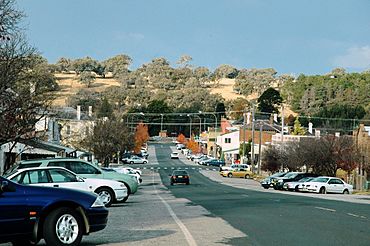Molong facts for kids
Quick facts for kids MolongNew South Wales |
|||||||||
|---|---|---|---|---|---|---|---|---|---|

The main shopping area of Molong, Bank Street
|
|||||||||
| Established | 1849 | ||||||||
| Postcode(s) | 2866 | ||||||||
| Elevation | 565 m (1,854 ft) | ||||||||
| Location |
|
||||||||
| LGA(s) | Cabonne Shire Council | ||||||||
| State electorate(s) | Orange | ||||||||
| Federal Division(s) | Calare | ||||||||
|
|||||||||
Molong is a small town in the Central West region of New South Wales, Australia. It is part of the Cabonne Shire.
Contents
Molong's History and Origins
The name Molong comes from an Aboriginal word. It means 'all rocks'.
Early Settlement and Growth
Cattle were brought to the Molong area as early as 1819. In 1826, a military and police outpost was set up here. This was ordered by Governor Darling. It helped open up land west of the Macquarie River for new settlers. For its first 20 years, the settlement was about 1.5 kilometers east of the current town. The Molong we know today was officially recognized in March 1849. In 1845, copper was found at Copper Hill, just north of the town.
Molong Historical Museum
The Molong Historical Museum is in an old hotel building from 1856. A builder named James Mortal built it. In 1861, he sold it to John Smith. The building was rented out to different hotel managers. Later, it became a home and office for doctors. The Historical Society bought it in 1969 to use as a museum. The Molong Shire Council helped them.
Recent Events in Molong
In November 2022, many buildings in Molong were damaged by a flood.
Heritage-Listed Places in Molong
Molong has several sites that are important for their history. They are called heritage-listed sites.
- Molong railway station: This is part of the Main Western railway line.
- Grave of Yuranigh: This grave is about 3 kilometers southeast of Molong on Yuranigh Road.
Molong's Geography and Location
Molong is located on the Mitchell Highway. It is about 300 kilometers west of Sydney. It is also about 30 kilometers from the city of Orange. The town is 529 meters above sea level. In 2021, the population of Molong was 1,621 people. Charles Sturt, a famous explorer, visited Molong in 1828. Molong was also home to one of Australia's first copper mines. This mine was at Copper Hill, just outside the town.
Railway Connections
The railway line from Sydney reached Molong in 1886. It was later extended to Parkes. A branch railway line to Dubbo opened in 1925. However, this branch line closed in 1987.
Molong's Climate
Molong has a humid subtropical climate (Cfa). This means it has warm to hot summers. Winters are cool to cold, and it sometimes snows. Temperatures have been recorded since 1907. Extreme temperature records were kept between 1957 and 1975.
One of the most extreme weather events was a snowfall on July 5, 1900. The snow was about 30 centimeters deep in town. In some areas, snow drifts were reported to be as deep as 3.3 meters.
| Climate data for Molong (Hill St, 1907–1975, rainfall 1884–2022); 565 m AMSL; 33.09° S, 148.86° E | |||||||||||||
|---|---|---|---|---|---|---|---|---|---|---|---|---|---|
| Month | Jan | Feb | Mar | Apr | May | Jun | Jul | Aug | Sep | Oct | Nov | Dec | Year |
| Record high °C (°F) | 42.3 (108.1) |
40.0 (104.0) |
37.8 (100.0) |
32.8 (91.0) |
27.2 (81.0) |
23.3 (73.9) |
21.7 (71.1) |
25.7 (78.3) |
32.8 (91.0) |
33.9 (93.0) |
37.8 (100.0) |
40.3 (104.5) |
42.3 (108.1) |
| Mean daily maximum °C (°F) | 31.0 (87.8) |
30.1 (86.2) |
27.5 (81.5) |
22.5 (72.5) |
17.4 (63.3) |
14.0 (57.2) |
12.9 (55.2) |
14.7 (58.5) |
18.6 (65.5) |
22.6 (72.7) |
26.4 (79.5) |
29.5 (85.1) |
22.3 (72.1) |
| Mean daily minimum °C (°F) | 13.3 (55.9) |
13.2 (55.8) |
10.3 (50.5) |
6.0 (42.8) |
2.8 (37.0) |
0.9 (33.6) |
−0.1 (31.8) |
0.6 (33.1) |
2.4 (36.3) |
5.4 (41.7) |
8.4 (47.1) |
11.4 (52.5) |
6.2 (43.2) |
| Record low °C (°F) | 3.4 (38.1) |
2.2 (36.0) |
0.6 (33.1) |
−2.9 (26.8) |
−6.7 (19.9) |
−7.8 (18.0) |
−8.8 (16.2) |
−7.2 (19.0) |
−4.4 (24.1) |
−4.4 (24.1) |
−0.6 (30.9) |
1.7 (35.1) |
−8.8 (16.2) |
| Average precipitation mm (inches) | 69.8 (2.75) |
57.0 (2.24) |
58.2 (2.29) |
51.4 (2.02) |
52.3 (2.06) |
59.9 (2.36) |
59.4 (2.34) |
61.5 (2.42) |
54.0 (2.13) |
58.4 (2.30) |
60.6 (2.39) |
64.1 (2.52) |
707.7 (27.86) |
| Average precipitation days (≥ 0.2 mm) | 6.6 | 5.7 | 5.7 | 5.4 | 7.3 | 9.6 | 10.4 | 9.5 | 8.2 | 7.9 | 6.8 | 6.5 | 89.6 |
| Source: Australian Bureau of Meteorology | |||||||||||||
| Historical population | ||
|---|---|---|
| Year | Pop. | ±% |
| 1921 | 1,503 | — |
| 1933 | 1,531 | +1.9% |
| 1947 | 1,662 | +8.6% |
| 1954 | 1,791 | +7.8% |
| 1961 | 1,655 | −7.6% |
| 1966 | 1,430 | −13.6% |
| 1971 | 1,383 | −3.3% |
| 1976 | 1,504 | +8.7% |
| 1981 | 1,374 | −8.6% |
| 1986 | 1,400 | +1.9% |
| 1991 | 1,563 | +11.6% |
| 1996 | 1,604 | +2.6% |
| 2001 | 1,560 | −2.7% |
| 2006 | 1,569 | +0.6% |
| 2011 | 1,629 | +3.8% |
| 2016 | 1,674 | +2.8% |
| 2021 | 1,621 | −3.2% |
| Source: Australian Bureau of Statistics data. | ||
Education in Molong
Molong has schools for students of different ages.
- Molong Central School
- St Joseph's Catholic Schools


